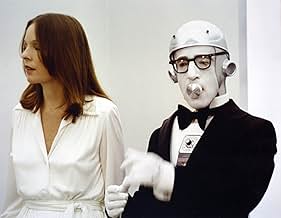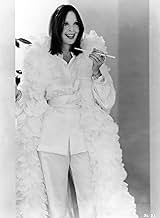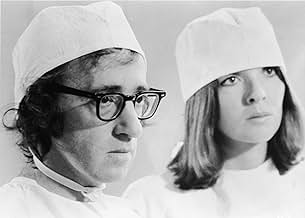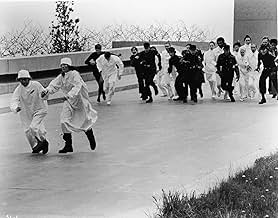VALUTAZIONE IMDb
7,1/10
45.801
LA TUA VALUTAZIONE
Il proprietario di un negozio da nerd viene riportato in vita dalla criostasi in un mondo futuro per combattere un governo oppressivo.Il proprietario di un negozio da nerd viene riportato in vita dalla criostasi in un mondo futuro per combattere un governo oppressivo.Il proprietario di un negozio da nerd viene riportato in vita dalla criostasi in un mondo futuro per combattere un governo oppressivo.
- Premi
- 2 vittorie e 2 candidature totali
Mews Small
- Dr. Nero
- (as Marya Small)
Stanley Ralph Ross
- Sears Swiggles
- (as Stanley Ross)
John Cannon
- Various Voice-Overs
- (voce)
- (non citato nei titoli originali)
Myron Cohen
- Robot Tailor
- (non citato nei titoli originali)
Recensioni in evidenza
A futuristic comedy from Woody Allen in 1973 has him waking up from an operation 200 years later (in 2173) to find society has gone berserk.
Clever, witty, and very funny. Allen is hysterically funny as the "sleeper" who gets to give history lessons on the 1970s, pose as a robot, and become a revolutionary to be near Diane Keaton.
Filled with sight gags galore and great one-liners. The giant vegetables and chicken are funny. And so is the "1984" political humor that fits the Bush era better than it did the Nixon era. Also very funny is Allen's extended Blanche du Bois speech.
Allen is excellent as is Keaton. John Beck plays a revolutionary. Mary Gregory is the doctor. George Furth is a party guest. Jackie Mason does the voice of the Jewish tailor.
A must see.
Clever, witty, and very funny. Allen is hysterically funny as the "sleeper" who gets to give history lessons on the 1970s, pose as a robot, and become a revolutionary to be near Diane Keaton.
Filled with sight gags galore and great one-liners. The giant vegetables and chicken are funny. And so is the "1984" political humor that fits the Bush era better than it did the Nixon era. Also very funny is Allen's extended Blanche du Bois speech.
Allen is excellent as is Keaton. John Beck plays a revolutionary. Mary Gregory is the doctor. George Furth is a party guest. Jackie Mason does the voice of the Jewish tailor.
A must see.
We are blessed that Woody was around, making movies as interesting as this when he was.
Already with this one, he began his vast exploration of movie techniques and devices that would last 25 years or so.
The idea is simple in this one: he wanted to use film slapstick from a bygone era. How better to situate that than to move the whole picture into a future era?
We have some truly classic stuff here. The banana joke, The mirror joke. The robot pantomime. The acting out of the Jewish dinner (done in later movies too). The inflated man joke. You can find all these in any number of Keaton. Marx, Laurel & Hardy movies.
The unifying string of time travel, a romance, the leader and his nose is too weak to make this a solidly recommended outing. And it wouldn't be for a couple years until Woody cared about the cinematography at all.
I had forgotten how pretty Diane Keaton was. Very.
Ted's Evaluation -- 2 of 3: Has some interesting elements.
Already with this one, he began his vast exploration of movie techniques and devices that would last 25 years or so.
The idea is simple in this one: he wanted to use film slapstick from a bygone era. How better to situate that than to move the whole picture into a future era?
We have some truly classic stuff here. The banana joke, The mirror joke. The robot pantomime. The acting out of the Jewish dinner (done in later movies too). The inflated man joke. You can find all these in any number of Keaton. Marx, Laurel & Hardy movies.
The unifying string of time travel, a romance, the leader and his nose is too weak to make this a solidly recommended outing. And it wouldn't be for a couple years until Woody cared about the cinematography at all.
I had forgotten how pretty Diane Keaton was. Very.
Ted's Evaluation -- 2 of 3: Has some interesting elements.
Sleeper was a very interesting project for Allen. He had spent time doing stand up, and up until this, his movies had been written around the jokes. With the exception of Play it Again, Sam, they were a series of sketches loosely tied into a weak plot. Sleeper was the beginning of the end of this. While the plot is somewhat "sit-com-ish", it was still there, and viewers always kept it in mind. It was also loose enough that Allen could incorporate scenes paying homage to the early silent film stars (the scene with the flying suits is my personal favorite). Miles Monroe was also a rip off from Bob Hope's cowardly hero personalities, but Allen gave it his own twist, and, in my opinion, made it much better. All in all, Allen achieved the perfect blend of slapstick and substance for those in need of a simple comedy. It lacks the depth of some of his better films, but if you want to laugh, this is for you.
Oh, and if you find it somewhat intellectually devoid, try Love and Death. It was his next film, and he added less slapstick and more highbrow comedy, as well as a little more real drama and substance.
Oh, and if you find it somewhat intellectually devoid, try Love and Death. It was his next film, and he added less slapstick and more highbrow comedy, as well as a little more real drama and substance.
In this early comedy, Woody Allen plays Miles Monroe, a twentieth century healthfood restaurant owner and jazz clarinettist who is cryogenically frozen after surgery and awoken two centuries later. The America of 2173 is a totalitarian state ruled by an oppressive dictator, and Miles has been reanimated by a group of rebels fighting to overthrow the government. For reasons too complex to set out here, Miles is forced to go on the run disguised as a robot and finds himself falling in love with his new owner, an attractive but intellectually vacant young woman named Luna. The film recounts how Miles wins Luna over to the rebel cause and tells the story of their fight against the regime.
Unlike some of Woody's later films, this is a pure comedy. It does not try to explore philosophical issues or to analyse the human condition in the same way as, say, "Hannah and her Sisters" or "Crimes and Misdemeanours". Although I normally think of Woody as a master of verbal wit, much of the humour in "Sleeper" is physical slapstick, based upon (and no doubt deliberate homage to) the comedians of the silent era such as Charlie Chaplin or Buster Keaton. (I particularly liked the scenes where Woody is disguised as a robot and those where the villains are attempting to clone the dictator, killed in a bomb explosion, from his nose). The links with that era are reinforced by the musical score, composed by Woody himself, in a jazz/ragtime style reminiscent of the 1910s and 1920s. The sets, by contrast, are very futuristic, with the clinical glass-and-chromium look of many science-fiction films. The combination of a futuristic theme with a traditional style of comedy is doubtless why the film was advertised under the slogan "Woody Allen takes a nostalgic look at the future".
This is not, however, simply a pastiche of silent humour like the one Mel Brooks was to attempt a few years later in "Silent Movie". This being a Woody Allen film, there is also a good deal of verbal humour, particularly one-liners along the lines of "I haven't seen my analyst in 200 years. He was a strict Freudian. If I'd been going all this time, I'd probably almost be cured by now". (As that line suggests, Miles is the typical, neurotically insecure Woody Allen character). As is often the case with humorous science-fiction (such as Douglas Adams's "Hitchhiker" books), the humour is frequently used to make satirical points about twentieth-century society as seen from the viewpoint of an imagined future. Contemporary worries about our diet are neatly satirised by a joke about how the science of two hundred years hence has proved that fatty foods and smoking are actually beneficial to health whereas what we now think of as healthfoods are regarded as unhealthy. This joke has remained topical because anxiety about what we eat is, if anything,even greater today than it was in 1973. There is perhaps also a dig at seventies "radical chic" as the vacuous conformist Luna becomes an equally vacuous revolutionary. (The plot of "Sleeper" seems to owe something to another tongue-in-cheek science-fiction film from a few years earlier, "Barbarella", which also dealt with rebellion against a dictator and even featured similar "orgasmatron" machines; the star of that film, Jane Fonda, had by 1973 become Hollywood's most famous radical chic actress).
The humour of "Sleeper" is often directed against figures from the sixties and seventies- perhaps too much so, as this type of humour tends to date very quickly. Some of it is still funny (such as Diane Keaton's Marlon Brando impersonation), but some can now be difficult to understand, particularly for non-Americans. (I had no idea, for example, who Howard Cosell was- apparently he was a sports commentator). That is, however, a minor quibble. Overall, this is an entertaining film and, in places, very funny, combining successfully two very different styles of humour. 7/10
Unlike some of Woody's later films, this is a pure comedy. It does not try to explore philosophical issues or to analyse the human condition in the same way as, say, "Hannah and her Sisters" or "Crimes and Misdemeanours". Although I normally think of Woody as a master of verbal wit, much of the humour in "Sleeper" is physical slapstick, based upon (and no doubt deliberate homage to) the comedians of the silent era such as Charlie Chaplin or Buster Keaton. (I particularly liked the scenes where Woody is disguised as a robot and those where the villains are attempting to clone the dictator, killed in a bomb explosion, from his nose). The links with that era are reinforced by the musical score, composed by Woody himself, in a jazz/ragtime style reminiscent of the 1910s and 1920s. The sets, by contrast, are very futuristic, with the clinical glass-and-chromium look of many science-fiction films. The combination of a futuristic theme with a traditional style of comedy is doubtless why the film was advertised under the slogan "Woody Allen takes a nostalgic look at the future".
This is not, however, simply a pastiche of silent humour like the one Mel Brooks was to attempt a few years later in "Silent Movie". This being a Woody Allen film, there is also a good deal of verbal humour, particularly one-liners along the lines of "I haven't seen my analyst in 200 years. He was a strict Freudian. If I'd been going all this time, I'd probably almost be cured by now". (As that line suggests, Miles is the typical, neurotically insecure Woody Allen character). As is often the case with humorous science-fiction (such as Douglas Adams's "Hitchhiker" books), the humour is frequently used to make satirical points about twentieth-century society as seen from the viewpoint of an imagined future. Contemporary worries about our diet are neatly satirised by a joke about how the science of two hundred years hence has proved that fatty foods and smoking are actually beneficial to health whereas what we now think of as healthfoods are regarded as unhealthy. This joke has remained topical because anxiety about what we eat is, if anything,even greater today than it was in 1973. There is perhaps also a dig at seventies "radical chic" as the vacuous conformist Luna becomes an equally vacuous revolutionary. (The plot of "Sleeper" seems to owe something to another tongue-in-cheek science-fiction film from a few years earlier, "Barbarella", which also dealt with rebellion against a dictator and even featured similar "orgasmatron" machines; the star of that film, Jane Fonda, had by 1973 become Hollywood's most famous radical chic actress).
The humour of "Sleeper" is often directed against figures from the sixties and seventies- perhaps too much so, as this type of humour tends to date very quickly. Some of it is still funny (such as Diane Keaton's Marlon Brando impersonation), but some can now be difficult to understand, particularly for non-Americans. (I had no idea, for example, who Howard Cosell was- apparently he was a sports commentator). That is, however, a minor quibble. Overall, this is an entertaining film and, in places, very funny, combining successfully two very different styles of humour. 7/10
I think I am going to have to rank this as Woody Allen's second-best (and second-funniest) movie... after the unbeatable "Annie Hall". Even after having seen the movie 3 or 4 times I still find myself amused by some of Allen's shtick... and his rarely-demonstrated adeptness at physical comedy. So many classic physical bits: riding around in the wheelchair... eating the rubber glove... the future scientists trying to force his slack body into a futuristic vehicle. After this movie Woody started to get a little too cerebral... this was his last attempt at a just-plain-funny movie... and probably his most satisfying of his early comedies... only because there was a sort-of storyline. Woody is cryogenically frozen after a botched operation in the 1970s and is awoken 200 years later to find himself in a repressive Orwellian future. He meets up with a spoiled rich chick (Diane Keaton) and influences her (not really intentionally) into becoming a revolutionary activist.
Lo sapevi?
- QuizWoody Allen originally intended the film to be three hours long and in two parts. The first part would have him in the present day, coping with life until his illness. And the second half would be the futuristic part. But United Artists rejected this concept.
- BlooperLuna's shoes change from high heels to flats when she crosses the lake on Miles' back (in the "raft" costume).
- Citazioni
Luna Schlosser: It's hard to believe that you haven't had sex for 200 years.
Miles Monroe: 204, if you count my marriage.
- ConnessioniEdited into Intimate Portrait: Diane Keaton (2001)
- Colonne sonoreTill We Meet Again
(1918) (uncredited)
Music by Richard A. Whiting
Lyrics by Ray Egan
Performed by Woody Allen
I più visti
Accedi per valutare e creare un elenco di titoli salvati per ottenere consigli personalizzati
- How long is Sleeper?Powered by Alexa
Dettagli
- Data di uscita
- Paese di origine
- Lingue
- Celebre anche come
- El dormilón
- Luoghi delle riprese
- Sculptured House - 24501 Ski Hill Drive, Golden, Colorado, Stati Uniti(mushroom shaped building, top of mountain on south side of I-70)
- Aziende produttrici
- Vedi altri crediti dell’azienda su IMDbPro
Botteghino
- Budget
- 2.000.000 USD (previsto)
- Lordo Stati Uniti e Canada
- 18.344.729 USD
- Lordo in tutto il mondo
- 18.344.868 USD
Contribuisci a questa pagina
Suggerisci una modifica o aggiungi i contenuti mancanti

Divario superiore
By what name was Il dormiglione (1973) officially released in India in English?
Rispondi

































